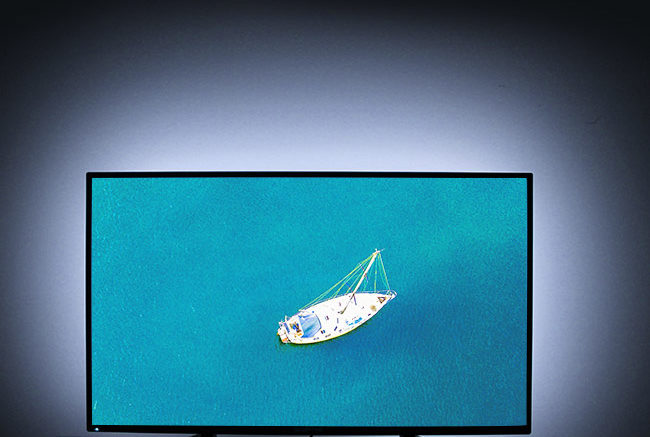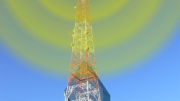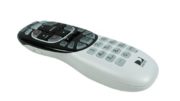Bias lighting. If you’re not familiar with the term, you should be. A bias light is the perfect accessory for your wall-mounted TV and it’s one of the best “bang-for-the-buck” improvements you can make. A simple strip of lights placed behind your TV can make your viewing experience soooooo much better.
What is a bias light?

A bias light is just a fancy term for a backlight. It’s a strip of lights that sticks to the back of your TV. It shines on the wall behind the TV and the result is sort of like what you see at the top of this article. It creates a more consistent environment for watching TV, and that’s good.
Your eye is like a camera
In order to understand why bias lighting works, you need to realize that your eye is like a camera. Or, if you really want to be correct, a camera is like your eye, since your eye came first. The qualities of a camera that make it take good pictures are the same qualities your eye has, and there are three qualities that really need to be considered when you’re watching TV in the dark.
Aperture
When we talk about cameras, we use the term “aperture” to describe the amount of light that gets to the image sensor. Your eye has the same mechanism. When it’s darker, your pupils get bigger, letting more light hit your retina.
In a very dark room, your eyes open to let in as much light as possible. But, when you turn on the TV, your eyes try to adjust. The darkness of the room seems darker, and things on the TV seem lighter.
This is bad because you’re straining your eyes, and they will eventually start to hurt. It’s also bad because you’re not really seeing the image on the screen the way it was intended.
Dynamic range
We tend to think of dynamic range as a property of displays (like television) but it’s also applicable to both cameras and eyes. Dynamic range is the difference between the brightest bright part of an image and the darkest dark part of an image. If an image is super-bright, your eyes won’t be able to really see shadow detail.
As you get older, your eyes have a harder time with dynamic range. This is why older folks were more likely to complain about that infamously dark episode of Game of Thrones. It’s also why older folks don’t like going out when it’s dark.
Watching TV in a dark room is going to even further limit the dynamic range your eye can perceive, while making sure there’s a light on will help balance that out.
Adaptability
Another thing we need to consider, expecially as we age, is how quickly our eyes adjust to new lighting conditions. As we watch television, naturally our eyes struggle to keep up when things go from light to dark. Using a bias light helps our eyes keep at the same level consistently. this means fewer headaches and an easier viewing experience.
Looking to learn more?
Here’s a quick video that explores the unique way the bias light is wired. This technique, based on a simple principle of electricity, explains how it’s possible to cut the bias light to size and still have it work.
Get this bias light from Solid Signal

Solid Signal’s Bias Light Kit gives you 78 inches of lights on a handy, adhesive-backed strip. Amazingly, this kit is designed so that you can cut it to the length you need. Just stick it around the edges of the back of your TV and cut off any excess. Connect it to your TV’s USB port and you won’t even have to plug it into the wall. It’s full of high-efficiency LED lights which use barely any power and it’s a great, inexpensive upgrade to any home entertainment system!





